As technology grows and improves, the way we interact with businesses also evolves — and Thailand is no exception. Self-ordering system in Thailand – ระบบสั่งออเดอร์สินค้าด้วยตนเองในประเทศไทย is booming across restaurants, retail outlets, and even service industries. Diners and shoppers can now purchase products and services without staff intervention.
So, why is this technology booming in Thailand, and how exactly is it reshaping customer experiences? Let’s dive in.
Self Ordering System in Thailand – ระบบสั่งออเดอร์สินค้าด้วยตนเองในประเทศไทย
In this blog, we’re going to cover everything you need to know about self-ordering systems in Thailand (ระบบสั่งออเดอร์ด้วยตนเองในประเทศไทย) — what it is, how it works, the advantages, challenges, and why it’s becoming a must-have for modern businesses.
What is a Self-Ordering System?
A self-ordering system is a technology solution that enables customers to order food, drinks, or products without staff assistance. Instead, they interact with:
- Touchscreen kiosks (คีออส)
- Tablets at restaurants
- Mobile apps and websites
- Self-checkout counters
If you’ve ever been to McDonald’s Thailand or KFC, you’ve likely seen these kiosks. Customers browse menus, choose items, pay electronically, and receive either a printed receipt or an order number.
But it’s not limited to fast food. Today, self-ordering systems are found in cinemas, supermarkets, convenience stores, and even hotel check-ins. The purpose is simple: eliminate friction, speed up service, and give consumers more control.
Why Self-Ordering Systems are Thriving in Thailand
Thailand’s tech ecosystem and lifestyle trends make it fertile ground for this innovation. Here are the key reasons:
1. Efficiency and Convenience
Bangkok and other urban centers are busy. People value speed. Self-ordering systems cut queue times, reduce waiting, and allow restaurants to serve more customers at peak hours.
Also read: How to Get Discounted Group Rates for CPR
2. Tourism Industry Needs
Thailand welcomes millions of tourists each year. Language barriers often create challenges. Self-ordering kiosks with multilingual options make the process smoother for visitors, improving their experience.
3. Digital-First Consumers
Thai youth are tech-savvy and excited by automation. Post-Covid, the demand for contactless service (บริการแบบไม่สัมผัส) skyrocketed. Self-ordering systems align perfectly with this shift.
Advantages of Self-Ordering Systems
Businesses and customers both benefit. Let’s explore how:
Enhanced Efficiency
Orders go directly into the system. Staff can focus on preparing food or delivering service instead of writing down orders.
Improved Accuracy
No more misheard items. Customers review their order before confirming, minimizing mistakes.
Upselling & Personalization
Smart systems recommend add-ons (e.g., suggesting a dessert when you order coffee). This boosts average order value while enhancing satisfaction.
Labor Cost Savings
While not replacing staff completely, these systems reduce front-line staffing needs. Businesses can allocate resources elsewhere.
Multilingual Support
With tourists from China, Japan, Europe, and beyond, kiosks offering ภาษาไทย, English, 中文, 日本語 ensure inclusivity.
Seamless Payments
Self-ordering integrates cash, cards, and Thai e-wallets like PromptPay, TrueMoney Wallet, ShopeePay.
Real-World Examples in Thailand
Self-ordering systems are no longer experimental — they’re mainstream.
- Restaurants: McDonald’s, KFC, and Burger King were pioneers. Local restaurants in Siam Paragon, CentralWorld now deploy tablet-based systems at tables.
- Convenience Stores: 7-Eleven Thailand has piloted self-checkout kiosks in select branches. Customers scan barcodes, review items, and pay instantly.
- Cinemas: Major Cineplex and SF Cinema offer full self-ordering kiosks for ticket purchases.
- Supermarkets: Big C and Lotus’s (Tesco Lotus) are testing self-checkout counters, letting shoppers scan and bag their groceries.
Challenges of Self-Ordering Systems in Thailand
Of course, every innovation comes with hurdles.
- High Initial Costs – Kiosks and software require heavy upfront investment, which may limit small businesses.
- Tech Barriers for Seniors – Older customers may resist using machines. Many stores offer hybrid options (manual + self-ordering).
- System Downtime – Technical glitches can frustrate customers if not fixed quickly.
- Customer Experience Balance – Some diners still value human interaction, so businesses must balance automation with hospitality.
The Future of Self-Ordering in Thailand
The trajectory is upward. Here’s what’s coming next:
- AI and Machine Learning: Systems will remember your preferences (e.g., your favorite bubble tea order) and suggest them automatically.
- Mobile-First Ordering: Integration with apps for pre-ordering and pickup will expand.
- Sustainability Focus: More restaurants will go paperless with e-receipts and eco-friendly kiosk designs.
- Data-Driven Insights: Businesses will use purchase data to refine menus, pricing, and promotions.
Boost Your Business with Self-Ordering
Self ordering system in Thailand – ระบบสั่งออเดอร์สินค้าด้วยตนเองในประเทศไทย is not just a passing trend — it’s the future of customer service. From speeding up operations to pleasing digital-first users, the benefits are massive.
Whether you’re a restaurant owner, retailer, or cinema manager, keeping an eye on this technology is crucial. For consumers, it’s a glimpse into how dining and shopping will look in the years ahead.
👉 Question for you: Have you tried a self-ordering system in Thailand? Did it make your experience better? Share your thoughts in the comments!

